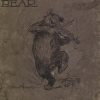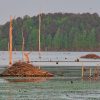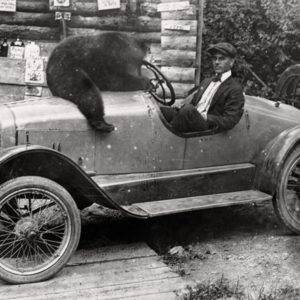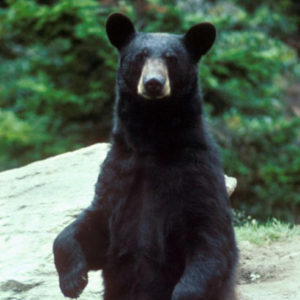calsfoundation@cals.org
Black Bears
aka: Ursus americanus
Black bears have a rich and varied history in Arkansas. Once giving to the state its unofficial nickname (the “Bear State”), bruins long shaped society and culture in Arkansas and continue to do so. Used for meat, fur, and fat, bears were a valuable commodity in the colonial period. By the early nineteenth century, although bears were still prized for their original uses, the bear-human relationship began to shift toward overt exploitation and bear hunting as a quest for masculine identity. By the first decades of the twentieth century, Arkansas black bears were at the brink of extirpation, but the population has since been revived.
Native Americans were the first to hunt black bears in the region. Documented evidence of an abundance of bears in what would become Arkansas dates back to early European exploration. Increasingly intense utilization of black bears by the French and Spanish was seen from the early eighteenth century onward. By the first decades of the 1700s, large groups of hunters trudged through the hills and deltas seeking all types of available wildlife but were especially interested in bears. Bear fat—more than meat or fur—was prized for its multiple uses, including fuel for oil lamps, insect repellent, and hair gel. Indeed, through much of the eighteenth and early nineteenth centuries, bear products represented a key segment of the local economy. Before unregulated mass hunting destroyed the bruin population, large numbers of bears were found statewide, centering not only in the Ozark Plateau and Ouachita Mountains but also throughout canebrakes, river valleys, and the Delta.
Arkansas black bears play the starring role in some of the most important and well-known literary pieces of early nineteenth-century literature and folklore. Known throughout the young United States (and through much of Europe) as a hunter’s paradise, Arkansas Territory (and, by 1836, the state of Arkansas) was a prime destination for domestic and foreign hunters. Among the most famous of these was Friedrich Gerstäcker, a German tourist and avid hunter who sought the ultimate experience in Arkansas in the late 1830s. Gerstäcker’s exploits while in the company of various Arkansas residents were later published in Europe and the United States leading to increased interest and hunting in the region. With Gerstäcker’s tales came some of the most powerful signs of bear hunting as a masculine endeavor—one in which utilization as the primary goal was replaced by adventure and a sense of reputation. This “honor” through hunting bears as exuded by Gerstäcker and others grew throughout the mid- to late nineteenth century and became a favorite topic for authors and humorists. “Fent” Noland’s articles in the Spirit of the Times and Thomas Bangs Thorpe’s “The Big Bear of Arkansas” further illuminated the close connection between black bears and the culture of nineteenth-century Arkansas.
As Arkansas’s population increased following the Civil War, newspapers across the state rang with stories concerning bear attacks or property destruction. The wilderness of Arkansas was slowly becoming populated, and this led to increased bear-human encounters and effectively changed black bears’ status in society. Remarkable stories of early hunters crawling into caves after bears turned to less romantic announcements of bears dragging off small children or devouring farmers’ pigs. As the latter stories increased, many of which were fanciful, so too did large-scale exploitive hunting of Arkansas bruins by market hunters seeking economic profit. Locals also shot bears on sight and, along with market hunters, used packs of dogs to help chase them down. By 1927, due to over hunting and habitat loss, black bears had become nearly extirpated in the state, with an estimated forty-five bruins remaining in the dense forested wetlands along the lower White and Cache rivers. That same year, the Arkansas Game and Fish Commission (AGFC) officially ended any hunting season for bears. The state nickname was changed as well—with Arkansas being officially recognized as the “Wonder State,” later known also as the “Natural State.”
Starting in 1959, and throughout the next decade, the AGFC released 256 black bears from Minnesota and Canada into Arkansas. With no hunting allowed until the 1980s, the new bear population thrived. Carefully regulated hunting in the last decades of the twentieth century and into the twenty-first century helped yield a stable bruin population. Although the presence of bears has yet to promote the widespread interest in Arkansas that it once did, their re-emergence throughout the Ozark Plateau and Ouachita Mountains has helped endorse the state’s campaign for its naturalness—a tourism movement based on the premise of the “Natural State.” In the first decade of the twenty-first century, the Arkansas black bear population throughout the state continued to prosper, numbering over 3,000.
For additional information:
Arkansas Game and Fish Commission. Arkansas Wildlife: A History. Fayetteville: University of Arkansas Press, 1998.
Arnold, Morris. Colonial Arkansas, 1686–1804: A Social and Cultural History. Fayetteville: University of Arkansas Press, 1991.
Clark, Joseph D., Rich Eastridge, and Michael J. Hooker. “Effects of Exploitation on Black Bear Populations at White River National Wildlife Refuge.” Journal of Wildlife Management 74 (September 2010): 1448–1456.
Gerstäcker, Friedrich. Wild Sports: Rambling and Hunting Trips through the United States of North America. Foreword by Robert Wegner. Mechanicsburg, PA: Stackpole Books, 2004.
Glymph, Caitlin M., Christopher Comer, Daniel Scognamillo, Daniel Unger, and Yanli Zhang. “Spatially Explicit Model of Areas between Suitable Black Bear Habitat in East Texas and Black Bear Populations in Louisiana, Arkansas, and Oklahoma.” MS thesis, Stephen F. Austin State University, 2017. Online at https://scholarworks.sfasu.edu/etds/128/ (accessed September 20, 2022).
Kristensen, Thea Vandervelde. “Ecology and Structure of Black Bear (Ursus americanus) Populations in the Interior Highlands of Arkansas.” PhD diss., University of Arkansas, 2013. Online at https://scholarworks.uark.edu/etd/838/ (accessed September 20, 2022).
Stith, Matthew M. “‘Denizens of the Forest’: Hunting Black Bears and Identity in the Mississippi Delta.” Arkansas Review: A Journal of Delta Studies 46 (December 2015): 163–172.
———. “‘Women Locked the Doors, Children Screamed, and Men Trembled in their Boots’: Black Bears and People in Arkansas.” Arkansas Historical Quarterly 66 (Spring 2007): 1–17.
Matthew M. Stith
University of Arkansas, Fayetteville
 Arkansaw Bear: A Tale of Fanciful Adventure
Arkansaw Bear: A Tale of Fanciful Adventure Mammals
Mammals Bear State
Bear State  Black Bear
Black Bear  Black Bear
Black Bear 




Comments
No comments on this entry yet.